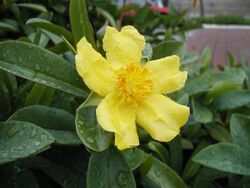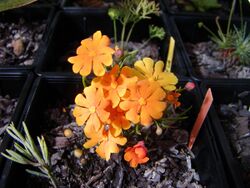Biology:Hibbertia
| Hibbertia | |
|---|---|

| |
| Hibbertia scandens | |
| Scientific classification | |
| Kingdom: | Plantae |
| Clade: | Tracheophytes |
| Clade: | Angiosperms |
| Clade: | Eudicots |
| Order: | Dilleniales |
| Family: | Dilleniaceae |
| Genus: | Hibbertia Andrews[1] |
| Species | |
| Synonyms[1] | |
|
List
| |

Hibbertia, commonly known as guinea flowers,[2] is a genus of flowering plants in the family Dilleniaceae. They are usually shrubs with simple leaves and usually yellow flowers with five sepals and five petals. There are about 400 species, most of which occur in Australia but a few species occur in New Guinea, New Caledonia, Fiji and Madagascar .
Description
Plants in the genus Hibbertia are usually shrubs, rarely climbers, and often form mats. Their leaves are usually arranged alternately along the stems, usually sessile, clustered on short side-branches, and have smooth, rarely toothed or lobed edges. The flowers are usually arranged singly in leaf axils or on the ends of stems and have five sepals, two "outer" sepals slightly overlapping the three "inner" ones. There are five yellow, rarely orange, petals and the stamens are usually arranged in three to five groups, sometimes on only one side of the carpels. There are between two and five carpels, usually free from each other, each containing up to six ovules and with a style on the top. The fruit is a follicle containing seeds, usually with an aril.[3][4][5]
Taxonomy and naming
The genus Hibbertia was first formally described in 1800 by Henry Cranke Andrews in his book The Botanist's Repository for New, and Rare Plants and the first species he described was H. volubilis, now known as H. scandens.[6][7][8] The name Hibbertia honours George Hibbert, a patron of botany and slave trader.[2][9][10] The common name, guinea flower reflects the resemblance of the flowers to the colour and shape of the guinea coin.[11]
Species list
References
- ↑ 1.0 1.1 "Hibbertia". Australian Plant Census. https://biodiversity.org.au/nsl/services/apc-format/display/90786.
- ↑ 2.0 2.1 "Hibbertia". State Herbarium of South Australia. http://www.flora.sa.gov.au/cgi-bin/speciesfacts_display.cgi?form=speciesfacts&name=Hibbertia.
- ↑ Toelken, Hellmut R.. "Hibbertia". Royal Botanic Gardens Victoria. https://vicflora.rbg.vic.gov.au/flora/taxon/73ff9ddb-8eea-4734-86a6-b32984e34356.
- ↑ "Hibbertia". Royal Botanic Garden Sydney. https://plantnet.rbgsyd.nsw.gov.au/cgi-bin/NSWfl.pl?page=nswfl&showsyn=&dist=&constat=&lvl=gn&name=Hibbertia.
- ↑ "Hibbertia". FloraBase. Western Australian Government Department of Parks and Wildlife. https://florabase.dpaw.wa.gov.au/browse/profile/22466.
- ↑ "Hibbertia". APNI. http://id.biodiversity.org.au/instance/apni/465034.
- ↑ Andrews, Henry Cranke (1800). The Botanist's Repository for New, and Rare Plants. 2. London: H.C.Andrews. p. 126. https://www.biodiversitylibrary.org/item/109209#page/108/mode/1up. Retrieved 9 July 2020.
- ↑ "Hibbertia scandens". Australian Plant Census. https://biodiversity.org.au/nsl/services/apc-format/display/90786.
- ↑ Corrick, M.G.; Fuhrer, B.A. (2001). Wildflowers of Victoria and adjoining areas. Australia: Bloomings Books. ISBN 1876473142.
- ↑ Kindy, Dave (21 September 2023). "Scientists want to rename the Hitler beetle — but not for the reason you think". Washington Post. https://www.washingtonpost.com/history/2023/09/24/hitler-beetle-offensive-species-names/.
- ↑ "Hibbertia scandens". Australian Plants Society NSW. https://resources.austplants.com.au/plant/hibbertia-scandens/.
Wikidata ☰ Q2709465 entry
 |


